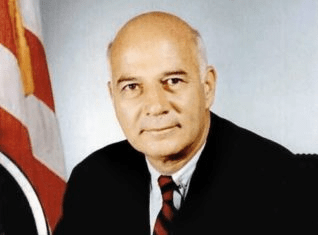Paul Ignatius (Iknadossian), Navy secretary at height of Vietnam War, dies at 104

He also served as president of The Washington Post and led a trade organization for airline companies.
Paul R. Ignatius, who served as secretary of the Navy at the height of the Vietnam War and spent two turbulent years as president of The Washington Post, died Nov. 6 at his home in Washington. He was 104.
His son David Ignatius, a Post journalist and novelist, confirmed the death but did not cite a specific cause.
The son of Armenian immigrants, Ignatius grew up in Southern California, served in the Navy during World War II and considered becoming a Hollywood scriptwriter or filmmaker. Instead he veered into business, getting an MBA from Harvard and helping launch a management-consulting firm called Harbridge House.
In 1961, he joined a wave of “whiz kids” entering the Pentagon to work under Robert S. McNamara, the defense secretary and former Ford Motor president.
Noting similarities between the two men, the New York Times later observed that “both demonstrate a certain coolness under fire, a grasp of small details in large, complicated problem areas, and an ability to organize and manage a staff effectively.”
Ignatius set to work streamlining supply chains, rising from Army procurement chief to assistant secretary of defense in charge of installations and logistics. By 1967 he supervised the movements of more than $115 billion worth of goods each year — “everything from mayonnaise to missiles,” he recalled — with a hand in the construction of six ports, six naval bases and 1,600 miles of paved roads in Vietnam.
That August, he was nominated for Navy secretary after McNamara’s first choice for the position — John McNaughton, an assistant secretary of defense — was killed in a plane crash.
Ignatius left the Pentagon in January 1969 following the election of President Richard M. Nixon. On the recommendation of McNamara, a friend of Post publisher Katharine Graham, he was named president of the newspaper and executive vice president of The Washington Post Co., which also owned Newsweek magazine and TV and radio stations.
Ignatius persuaded Graham to cancel plans for a new, I.M. Pei-designed headquarters for The Post in Washington. Rather than construct a new building, he argued, the company could expand its old offices on 15th Street NW for almost half the cost.
Drawing on his Pentagon experience supplying troops in Vietnam, he also pressed for a helicopter-accessible roof on the newly expanded Post building. That suggestion proved fortuitous for management in 1975, when a pressmen’s strike made helicopter one of the easiest ways to safely access the building and its printing presses.
Yet a barrage of management, labor and production problems proved difficult to handle.
In his 2006 memoir, “On Board,” Ignatius recalled that he unsuccessfully urged Graham to delay publication of the Pentagon Papers, the Defense Department’s top-secret history of U.S. involvement in the Vietnam War. The documents, which the Nixon administration tried to prevent the New York Times and The Post from printing in June 1971, led to a Supreme Court victory for the newspapers, a landmark ruling for First Amendment rights.
Ignatius, along with Post Co. board chairman Frederick S. “Fritz” Beebe, advised Graham that publishing the documents in defiance of a court order might jeopardize The Post’s initial public stock offering that same month. Ignatius later lauded Graham for her “courageous decision to publish.”
“Paul was a thoroughly nice, well-intentioned man, but he came from a very different culture and never really learned the communications business,” Graham wrote in her memoir, “Personal History.” She bought out his contract in 1971.
Ignatius later served for 15 years as head of the Air Transport Association, a trade organization of airline companies now known as Airlines for America, and testified before Congress on deregulation and other aviation-industry issues.
Paul Robert Ignatius was born on Nov. 11, 1920, in Glendale, California, where his family socialized with writer William Saroyan and director Rouben Mamoulian. His parents had emigrated from the former Ottoman Empire following the genocide of as many as 1.5 million Armenians.
His father ran a rug business and, as Ignatius told it, paid for his son’s full tuition at the University of Southern California after offering a free Oriental rug to the school’s president.
Ignatius graduated in 1942 and became a Navy ordnance officer, participating in the Battle of Leyte Gulf in the Philippines and surviving two kamikaze attacks on his ship. In 1947, he graduated from Harvard and married Nancy Weiser, who became an environmental activist and sang with the Grammy-winning Washington Chorus. She died in 2019.
In addition to his son David, survivors include three other children: Sarah Ignatius, a lawyer, novelist and former executive director of the National Association for Armenian Studies and Research; Amy Ignatius, a former New Hampshire state court judge; and Adi Ignatius, editor at-large of the Harvard Business Review. He is also survived by seven grandchildren and four great-grandchildren.
Ignatius was a member of the Federal City Council and Washington Institute of Foreign Affairs, among other organizations, and maintained a well-publicized love of tennis throughout his life. In 1967, Washingtonian magazine named him the second-best tennis player in the federal government, behind only national security adviser Walt W. Rostow.
Although he received decorations including the Defense Department’s Distinguished Public Service Award, Ignatius said his highest honor came in 2013, when the Navy announced that a destroyer would be named after him.
“It will sail virtually every ocean of the world,” Navy Secretary Ray Mabus said at the time. “It will be a reminder of the experience, and the wisdom, of Paul Ignatius.”





